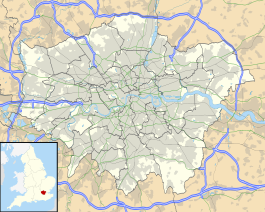Hornsey railway station
| Hornsey | |
|---|---|
 The southbound platform of the station and adjacent TMD. | |
| Location | Hornsey |
| Local authority | London Borough of Haringey |
| Managed by | Great Northern |
| Station code(s) | HRN |
| DfT category | D |
| Number of platforms | 2 |
| Fare zone | 3 |
| National Rail annual entry and exit | |
| 2019–20 | |
| 2020–21 | |
| 2021–22 | |
| 2022–23 | |
| 2023–24 | |
| Key dates | |
| 1850 | Opened |
| Other information | |
| External links | |
| Coordinates | 51°35′10″N 0°06′42″W / 51.5862°N 0.1116°W |
Hornsey railway station is in Hornsey in the London Borough of Haringey, north London. It is on the Great Northern route that forms part of the East Coast Main Line, 4 miles 4 chains (6.5 km) down the line from London King's Cross, and is situated between Harringay to the south and Alexandra Palace to the north.[2]
It is in Travelcard Zone 3. The station is managed by Great Northern on behalf of Network Rail, and is adjacent to the Hornsey train maintenance depot. It was built in 1850 on the Great Northern Railway.
History
[edit]The station was opened on 7 August 1850 by the Great Northern Railway (GNR),[3] the same day that the main line between Peterborough and London (Maiden Lane) was opened.[4] It was the first station on the line after King's Cross. Later in the century, maintenance sidings were established on both the up and down sides.
Under plans approved in 1897, the station was to be served by the Great Northern and Strand Railway (GN&SR), a tube railway supported by the GNR which would have run underground beneath the GNR's tracks from Alexandra Palace to Finsbury Park and then into central London. The GN&SR stations on each side would have been the same as the main line stations. The GN&SR route and stations north of Finsbury Park were cancelled in 1902 when the GN&SR was taken over by Charles Yerkes' consortium which planned to merge it with the Brompton and Piccadilly Circus Railway to form the Great Northern, Piccadilly and Brompton Railway from Finsbury Park to Hammersmith (now part of the London Underground's Piccadilly line).[5]
Service
[edit]All services at Hornsey are operated by Great Northern using Class 717 EMUs.
The typical off-peak service in trains per hour is:[6]
- 4 tph to Moorgate
- 2 tph to Stevenage via Hertford North
- 2 tph to Welwyn Garden City
During the peak hours, the station is served by an additional half-hourly service between Moorgate and Hertford North, and the service between Moorgate and Welwyn Garden City is increased to 4 tph. The station is also served by a small number of peak hour services between Moorgate and Gordon Hill.
| Preceding station | Following station | |||
|---|---|---|---|---|
| Great Northern Stopping Services | ||||
| Abandoned Plans | ||||
| Preceding station | Following station | |||
| Harringay towards Strand |
Great Northern & Strand | Alexandra Palace Terminus | ||
Connections
[edit]- Turnpike Lane London Underground station is a 15-minute walk away.

The Tottenham Lane entrance to Hornsey Station - A change to an adjacent platform at Finsbury Park station two stops away from Hornsey on the railway gives direct access on the overground lines to and from central London, south London, Gatwick and Brighton.
References
[edit]- ^ a b c d e "Estimates of station usage". Rail statistics. Office of Rail Regulation. Please note: Some methodology may vary year on year.
- ^ Padgett, David (October 2016) [1988]. Brailsford, Martyn (ed.). Railway Track Diagrams 2: Eastern (4th ed.). Frome: Trackmaps. map 14B. ISBN 978-0-9549866-8-1.
- ^ Butt, R.V.J. (1995). The Directory of Railway Stations. Yeovil: Patrick Stephens Ltd. p. 123. ISBN 1-85260-508-1. R508.
- ^ Awdry, Christopher (1990). Encyclopaedia of British Railway Companies. London: Guild Publishing. p. 135. CN 8983.
- ^ Badsey-Ellis, Antony (2005). London's Lost Tube Schemes. Capital Transport. pp. 77 and 138. ISBN 1-85414-293-3.
- ^ Table 24 National Rail timetable, May 2022
External links
[edit]- Train times and station information for Hornsey railway station from National Rail
- Rail transport stations in London fare zone 3
- DfT Category D stations
- Railway stations in the London Borough of Haringey
- Former Great Northern Railway stations
- Railway stations in Great Britain opened in 1850
- Railway stations served by Govia Thameslink Railway
- Proposed London Underground stations
- Unbuilt Great Northern, Piccadilly and Brompton Railway stations
- Hornsey

